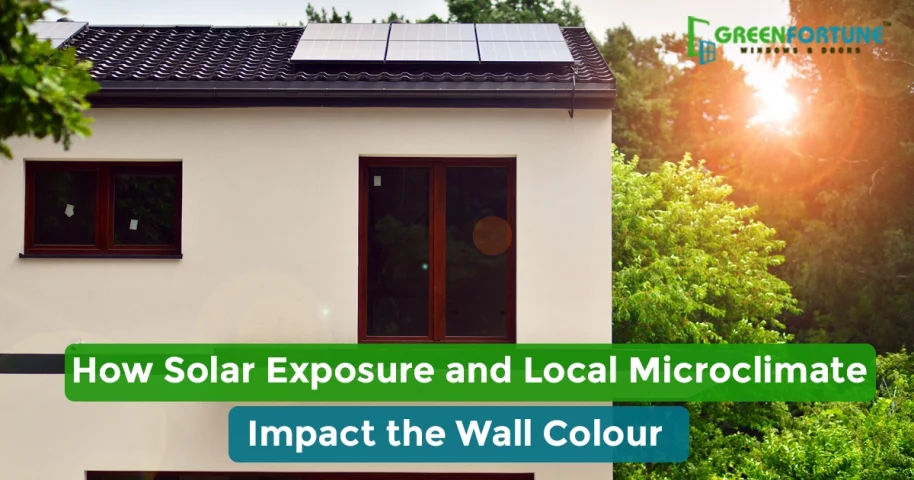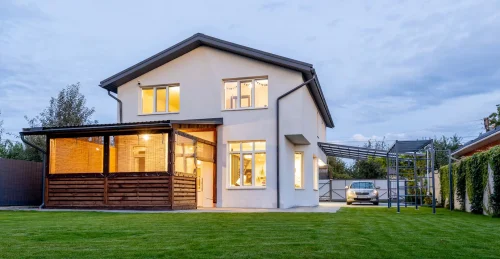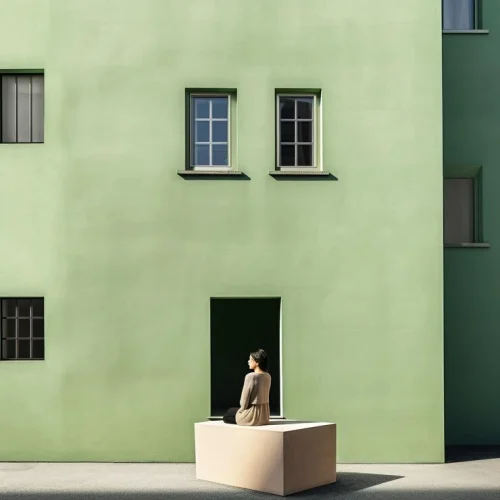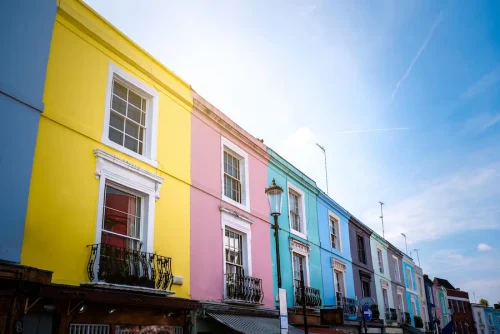
A Complete Guide to Wooden Moulded Doors: Advantages & Disadvantages
April 8, 2025
Distemper vs Emulsion: Choosing the Right Paint for Your Walls
April 9, 2025Interiors are often considered the heart and soul of the home. However, exteriors also play a crucial role in setting the first impression. Colour for exterior walls which is often neglected can make or break the impression for you. However, choosing home colours can be tricky as several factors have to be considered. Amongst all, solar exposure and local microclimate play a huge role. These two factors ensure that colour for home exterior is aesthetically pleasing and has a long life. Read on to know about exterior colour combinations for a house and how solar radiation affects it.
What is Solar Exposure?
Solar exposure refers to the amount of sunlight that hits exterior walls throughout the day. This energy consists of electromagnetic waves, including visible light, infrared radiation, and ultraviolet (UV) radiation. When we talk about exposure, we primarily focus on UV rays, which significantly impact the appearance and durability of wall surfaces.
Over time, prolonged exposure to UV rays can lead to discolouration and chipping of the colour for exterior wall. Understanding solar exposure is crucial for determining the longevity and performance of exterior wall paint.
Impact of Local Microclimate on Exterior Wall Colours
Microclimates significantly influence the durability and appearance of exterior wall colours. Humidity, temperature, wind patterns, and vegetation create unique conditions. These factors affect paint performance. Homeowners and builders must understand them. Here are some factors in which local microclimate impacts exterior wall colour:
- High humidity causes paint to retain moisture, leading to mould growth and premature chipping.
- Intense heat fades exterior wall colours and causes cracking, compromising both aesthetics and durability.
- Microclimates create temperature differences that affect paint performance, leading to uneven wear.
- Local wind conditions influence drying times, impacting the application and finish of the paint.
- Vegetation creates shaded areas that alter temperature and moisture levels, affecting paint longevity and choice.
Also Read: https://thegreenfortune.com/how-window-and-door-frame-colours-affect-mood/
Best Exterior Paints for House
Latex (Water-Based) Paint
Latex paint is an excellent exterior paint for houses in regions that face solar exposure. Its formulation allows it to face UV radiations easily thus maintaining the vibrancy of colour and preventing its fading. Another benefit of applying latex paint is that it can easily sustain the expansion and contraction caused due to heat. Whereas, its high breathability prevents the risk of mold and mildew development.
Oil-Based Paint
Oil based paints are suitable exterior home painting colours. Although, it takes a long time to dry its sturdy formulation gives high protection against UV rays. Oil-based paints are suitable for surfaces that require a tough and long lasting coating. However one should be mindful that it requires a longer drying time and thus should not be used for humid climates.
Acrylic Paint
Another great option that should be on your list is acrylic paints. These exterior wall colour have high radiation resistance and excellent colour retention. Since it dries quickly and forms a sturdy layer over the surface. Additionally, acrylic paint has low VOC content, making it an environmentally friendly option for homeowners.
Elastomeric Paint
Elastomeric paint is particularly beneficial for exterior surfaces exposed to harsh solar conditions. Its thick, rubber-like consistency allows it to expand and contract with temperature changes. This paint creates a waterproof barrier that protects against moisture buildup.
Stucco Paint
Stucco paint is specifically designed for stucco surfaces and is highly effective in areas with significant solar exposure. Its formulation includes UV-resistant additives that help prevent fading from prolonged sunlight. These are effective against the growth of mould that damages the painted surface and elevates the exterior’s appeal.
Read Here: https://thegreenfortune.com/how-wpc-plywood-is-different-from-normal-plywood/
Trendy Monochromatic Colour for Exterior Wall
Grey
Grey has been used widely as a colour for home outside due to its modern aesthetic. It has various shades from light to charcoal and can be used in different ways to create depth and dimension. Grey also reflects sunlight that helps to regulate indoor temperatures. Additionally, colour for exterior wall can be paired with different accent building colours enabling owners to personalise the space.
Brown
Brown is a warm monochromatic choice for exterior walls. It has rich tones that offer stability and warmth to the facade. The brown colour of the house like light tan or deep chocolate also absorbs light and helps to create a charming effect. It absorbs heat and sunlight effectively keeping the interior warm in cool climates.
Orange
Orange is a bold monochromatic choice for exterior walls. This colour for the exterior wall is ideal for those looking to create a lively ambience. Hence, this colour for exterior wall is suitable for beach homes or coastal areas. It captures the warmth of sunsets and the lively feel of tropical locations. You can pair orange colour with sea green or sea blue colour to highlight the architectural features.
Beige
Beige is a timeless and elegant monochromatic choice for exterior walls. Its warm undertones create a welcoming atmosphere while reflecting sunlight effectively, helping to keep homes cooler in warmer climates. Beige pairs beautifully with natural materials like wood and stone, enhancing the overall aesthetic.
Peach
Peach is a fresh and cheerful colour for an exterior house that brings warmth and vibrancy to any home. It has a soft undertone that makes your facade beautiful. Its light tone absorbs fewer UV rays, reducing heat buildup and minimises colour fading. This makes this colour for exterior wall an excellent choice for those looking to create a bright and uplifting exterior.
Greige
Greige as the name says is a blend of grey and beige. It is a unique colour combination that combines the warmth of beige and mute undertones of grey colour. It helps to create a neutral backdrop that complements different home types. Greige effectively reflects sunlight, contributing to a favourable microclimate that helps maintain cooler indoor temperatures.
Exterior Colour Combination for House
Cream and Brown
This house colour selection is perfect for creating a microclimate that elevates both comfort and energy efficiency. Brown absorbs heat while white colour keeps the home cool thus regulating temperature. Both colour for exterior wall have earthy tones and help to manage solar exposure while minimising wear and tear from UV rays.
White and Slate Grey
The combination of white and slate grey colours is a graceful option for the exterior walls. White elevates the home’s visibility keeping the interiors cool and casting sunlight. While grey adds a contemporary touch thus balancing the elegancy. The beautiful contrast between the two can be used to highlight architectural features.
Yellow with Brown
If you live in an area with a sunny climate and looking for a lively colour combination then this is for you. The bright yellow reflects sunlight while brown adds an earthy tone that absorbs heat keeping the house cool. Hence, this outer colour for the home minimises the fading effect of solar exposure while balancing aesthetics.
Also Check, https://thegreenfortune.com/top-5-ventilator-window-designs/
Green and Off-White
You can choose this colour for exterior wall due to its subtle connection to nature. Green being the lighter colour reflects sunlight and keeps the room cool. Whereas, off-white colour adds brightness and warmth feel to the walls. Both colours can sustain high-intensity sunlight without fading making it perfect for exterior walls.
Wrapping Up
In conclusion, choosing the right colour for your exterior walls means understanding solar exposure and local weather conditions. Factors like UV radiation, humidity, and temperature changes affect the durability and appearance of the colour for exterior wall. For more such tips and tricks you can check out other blogs at greenfortune.com.
FAQs
1. How does surface color affect microclimate?
Surface colours have a significant impact on microclimate. Light colours reflect solar radiation thus keeping home cool. While dark shades tend to absorb light and heat thus leading to warm indoors.
2. How to paint walls to reduce heat inside and outside the kitchen?
One can use light coloured exterior paints as they minimise heat absorption by deflecting light. You can also choose heat-resistant coating to elevate insulation.
3. How can sun exposure create a microclimate?
Sun exposure creates microclimates by influencing temperature, humidity, and vegetation growth. Direct sunlight favors certain vegetation types, whereas shaded areas keep temperatures cooler, resulting in diverse habitats and varying moisture levels nearby.
4. What are the factors that influence microclimate?
Microclimate factors include vegetation, topography, soil type, and human activities. These elements impact the climate thus affecting temperature, humidity, and overall environmental conditions in specific areas.











